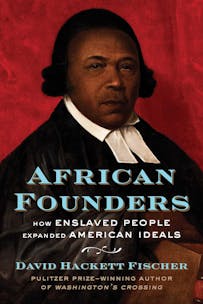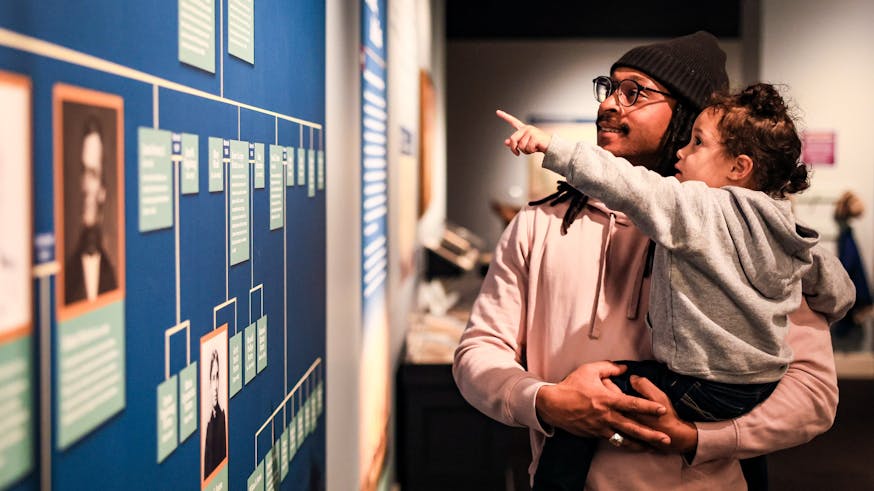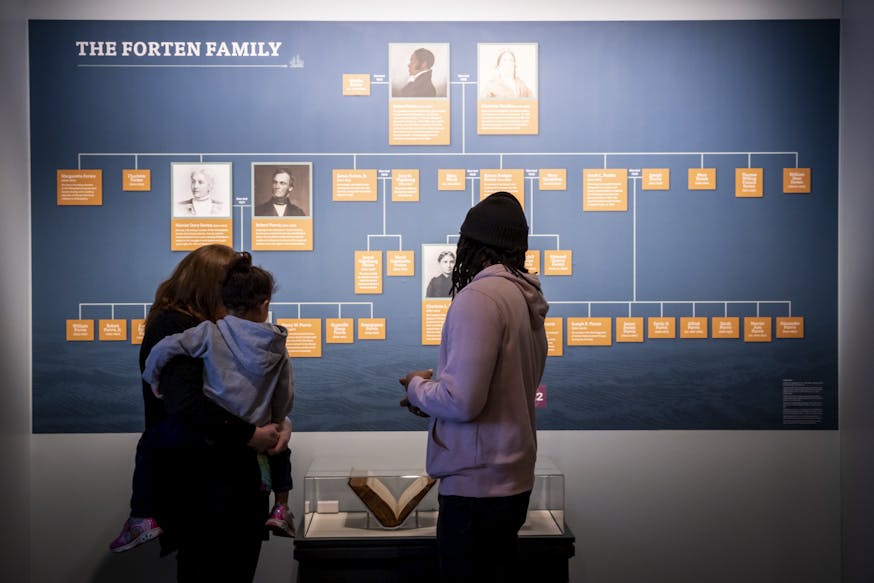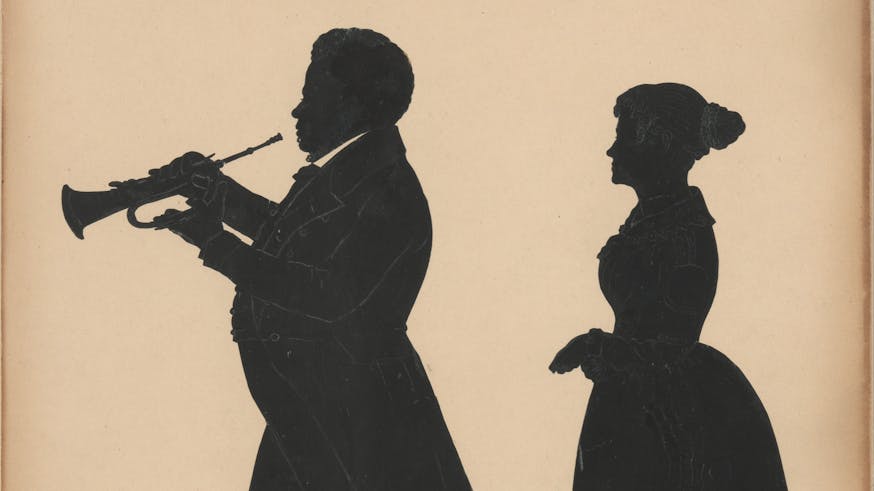Read the Revolution
African Founders
February 8, 2023
Purchase the book from Simon & Schuster.
In a new foundational book, African Founders: How Enslaved People Expanded American Ideals, Pulitzer Prize–winning historian David Hackett Fischer draws on extensive research to show how enslaved people of African descent and their descendants enlarged American ideas of freedom in different regions throughout the early United States, from New England all the way to Texas.
In the Museum’s new special exhibit, Black Founders: The Forten Family of Philadelphia, visitors are introduced to James Forten, whose status as a free Black Philadelphian was an exception in a city where the majority of the people of African descent were enslaved. Little is known about his parents, Thomas Forten and Margaret Waymouth Forten, but they were both free at the time that James was born on Sept. 2, 1766. Because a child’s status of freedom followed that of their mother, Margaret’s status as a free person passed onto her son, James, and his older sister, Abigail.
In African Founders, Fischer cites genealogists to discover what is known about earlier generations of the Forten family, also spelled “Fortune” on occasion, and highlights Forten’s heritage as one that connects to many regions of the early United States.
Read the excerpts to learn more about his father, Thomas, and then the story of Forten’s aunt, Ann Elizabeth Fortune, who lived as a single free Black woman in Philadelphia, and how Quaker abolitionist Anthony Benezet befriended the Forten family.
Excerpt 1
People of color in Pennsylvania also succeeded as leaders in other ways. Most prominent among them was James Forten (1766-1842). He had been born free in Philadelphia, and wrote with pride that his father, Thomas Forten, also “never wore the yoke.” He was the nephew of Ann Elizabeth Fortune, who with her brother Thomas had been free born in Maryland.
They moved to Philadelphia, and Thomas Forten became an apprentice sailmaker working beside a white apprentice named Robert Bridges who became a close friend. Bridges inherited money enough to start his own sailmaking business. He hired Forten, and they continued to work together.
Thomas Forten married a free Black woman named Margaret Waymouth, who was born about 1722 and died 1806 at the age of eighty-four. According to family tradition her father or grandfather had been born a slave and gained his freedom.
Thomas and Margaret Forten lived in Philadelphia at Third and Walnut Streets, and belonged to an Anglican church, probably St. Paul’s, which was near their home. At the age of forty-one Margaret gave birth to her daughter Abigail in 1763, and at forty-four to her son James on September 2, 1766.
When very young James Forten learned to read, write, and cipher. He was also taught Quaker ethics of humanity, right conduct, hard work, and serious striving. One of his teachers was Anthony Benezet, a family friend. In 1773, Forten’s father died suddenly, and James went to work at the age of six. Benezet found him a job in a grocery store.
Sign Up
Get biweekly Read the Revolution featured excerpts right to your inbox.
Excerpt 2
In the city of Philadelphia, on August 10, 1768, Ann Elizabeth Fortune sat down to write her last will and testament. She began by describing herself as a “free Negroewoman born in His Majesty’s Dominions,” single and never married. With no husband or children of her own, she left a large estate to her niece Abigail Forten, aged five, daughter of her brother Thomas Forten, who also lived in Philadelphia.
There was much for Abigail to inherit. Her aunt owned a handsomely furnished house on Chestnut Street near the center of Philadelphia. The will mentioned a feather bed, walnut furniture, looking glasses, paintings, fine china, silverware, jewelry, a wardrobe of “silk and dimity gowns,” a bolt of “green satin” cloth, and more.
All those cherished possessions were to be preserved for Abigail and given to her when she came of age. The house itself was ordered to be sold, and the proceeds invested with great care, for Abigail’s use when she turned twenty-one. Detailed instructions made clear that this “free Negroewoman” knew much about managing money in early Philadelphia.
Historians have been curious to know more about Ann Elizabeth Fortune and the source of her wealth. One clue appears in her will. This “free Negroewoman” owned an African slave named Jane, whom she ordered to be emancipated. Another clue was a notice that had appeared twenty-seven years earlier, in the Pennsylvania Gazette on October 3, 1751: To be sold, a Parcel of likely Negroes, very reasonable.... N. B. Said Negroes may be seen at a Free Negroe Woman’s in Chestnut Street, opposite to Mr. Anthony Benezet’s.”
Ann Elizabeth Fortune was a neighbor and friend of Anthony Benezet, and he agreed to serve as executor of her estate. That connection confirms that she was the “Free Negroewoman in Chestnut Street” who worked in Philadelphia’s African slave trade.
Another question is about the origins of Ann Elizabeth Fortune herself. Her will tells us that she was born “in His Majesty’s Dominions,” and the language suggests that she may have been born free. This was where our knowledge ended until 2005, when the gifted genealogist Paul Heinegg published his major databases on freeborn African Americans in Maryland, Delaware, Virginia, and North Carolina during the seventeenth and eighteenth centuries. He found them in surprising numbers, and changed our fundamental understanding of race, slavery, and servitude in early America.
Heinegg identified thousands of free “people of color” in early America who descended from African slave fathers, and mothers who were freeborn white women, mostly servants who came to the Chesapeake colonies in the seventeenth and early eighteenth centuries. By law in many English colonies, children of mixed ancestry followed the status of their mothers. Infants with slave fathers and mothers who were indentured servants became free at birth. Other children of mixed ancestry who had slave mothers and free white fathers were not so fortunate. They became slaves at birth, again following the condition of the mother according to law and custom in many English colonies in North America.
On the lower Eastern Shore of Maryland and Virginia, Paul Heinegg discovered several “free mulatto women” in an extended family that took the name of Fortune or Forten. Both spellings were used in the same household, sometimes by the same person.
In 1743, a Maryland constable’s report described several of these women as “full as dark as most Mallatos.” Among them was Sarah Fortune, a “Mulatto” from Somerset County, Maryland, who had been baptized in 1715. Paul Heinegg was able to identify her as the mother of a song variously called Thomas Fortune or Forten (1740-73) who moved to Philadelphia and founded an eminent free African American family. This same Thomas Forten was the brother of Ann Elizabeth Fortune, and father of her heiress Abigail Forten. All were descended from Sarah Fortune, a free mulatto woman of Somerset County, Maryland, which solves the puzzle of ancestry.
Yet another puzzle is about Ann Elizabeth Fortune’s complex web of connections in Philadelphia. She formed close personal ties with women in Philadelphia’s most prominent Quaker families. A witness to her will was Hannah Cadwalader, mother of Lambert Cadwalader and matriarch in one of Philadelphia’s most eminent Quaker clans. Another witness was Margaret Stevenson, a niece of Hannah Cadwalader.
Ann Elizabeth Fortune was actively involved in the African slave trade and a slave owner herself. At the same time, her close friend and neighbor Anthony Benezet was an early leader of Philadelphia’s antislavery movement, a founder of African schools in the region, and Philadelphia’s most prominent advocate of human rights for African Americans in the mid-eighteenth century.
Anthony Benezet is less familiar to us today than other antislavery Quakers such as John Woolman, whose intense and intimate personal writings are still widely read. But in the judgment of French and British reformers, Anthony Benezet was the most influential antislavery writer in the western world.
At the same time, he also became executor of Ann Elizabeth Fortune’s estate, and the appraised of her property was Joseph Marriott, a Quaker relative of Anthony Benezet. This tangle of relationships differed from common understandings of race and slavery in early America. It also takes us to the heart of another unique system of bondage and freedom in early North America.
Three English colonies of West Jersey, northern Delaware, and eastern Pennsylvania comprised a distinct region in the Delaware valley. It was prosperous, and its thriving settlement of Philadelphia rapidly became the largest city in eighteenth-century North America above the Rio Grande.
The Delaware Valley and its metropolis were unique in their mix of cultures. This was a region where Quakers and Africans, prosperous slave traders and impassioned antislavery leaders, English and Scots-Irish, African slaves, flourishing “free Negroewomen,” and many others lived complex and closely connected lives. It was also a region that led the early American republic in formally opposing human bondage, and supporting many reform movements, with Africans and Quakers and many others working together as leaders in those causes.
David Hackett Fischer, African Founders: How Enslaved People Expanded American Ideals (Simon & Schuster, 2022), 257, 203-205.
Tags
Learn More

Black Founders: The Forten Family of Philadelphia
February 11 - November 26, 2023
Forten Family Heirlooms on Loan from Descendants in Black Founders Exhibit

